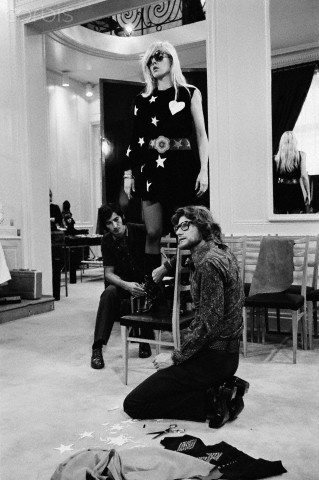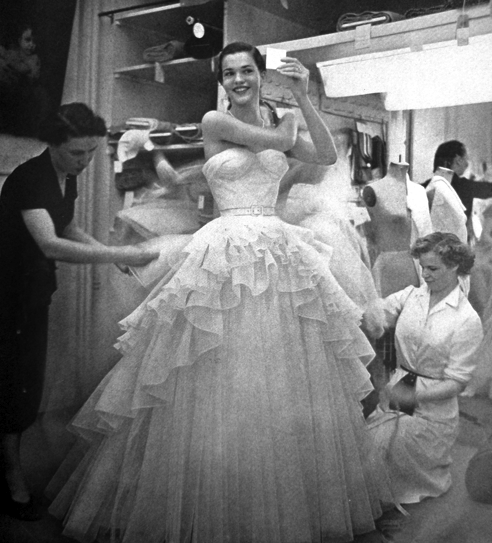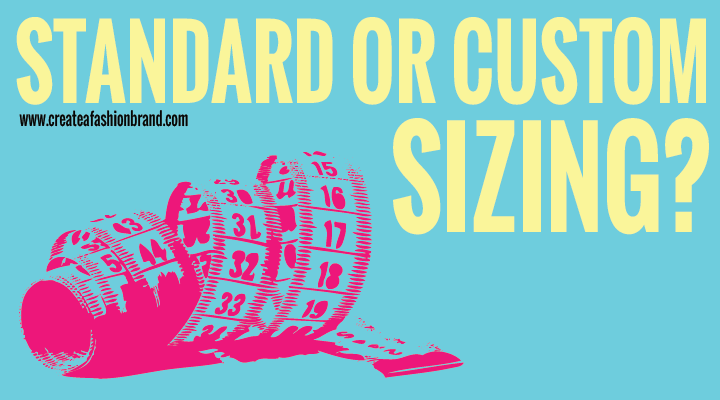So now you’re wondering how to figure out sizes and what measurements to use. Do I go with custom sizes? Do I use standard sizing like retail? Do I tweak them for my product? Do I measure my fit model?
All questions I get asked a lot about sizing. So in this post I want to talk about what the difference is between the different types of sizing. What affects the choices you will make and which one you should choose.
By the end of this post, you’ll be armed with the most accurate information for your brand and know exactly which one to choose for your fashion products.
STARTING AT THE BEGINNING
So first I need to explain exactly what these things are. Custom Sizes; Standard Sizing and a Fit Model:
STANDARD MEASUREMENTS.
Standard Measurements are measurements that have been averaged out from a large group of people in a specific country or area. All of the people who participate are measured for each body part and then these measurements are put into a spreadsheet. The average for each body part is calculated and this becomes the average or ‘Standard Measurement’ for that area or country.
These measurements are used to create your standard sizing of clothes for that part of the world because they are considered to fit the majority of people.
CUSTOM MEASUREMENTS
Custom measurements are exactly how they sound. They can refer to one person’s custom size when they are fitted for a suit or dress by a bespoke tailor or they can be used by a Fashion Brand to suit all of the customers who shop with them.
Custom can refer to any type of deviation from Standard Measurements. This can be as complicated as changing all of the body measurements [like a custom tailored suit] or simply one measurement [adding additional length to trousers for example].
FIT MODEL

A fit model is a person who is employed by fashion brands to try on clothes and are used by the technical team to test the fit of every sample.
Their body measurements are specified by the company who hires them and they are used by all departments to try on clothes as their fitting standard. Because of this, their weight has to remain stable to be employed.
THE PROCESS
So I should explain why I’m talking about models.
In the general process for most garment creation, it’s very common that once the initial samples are made, they then get tried on by a ‘Fit Model’. You would then make any changes you want to in terms of the fit or design and send the notes back to the factory or tailor. This repeats at every sample stage until you get the product and fit that you want.
This process is used in mass manufacturing by retailers and in bespoke luxury brands
The confusion comes when trying to decide which to choose first. Do you use the model’s measurements to make the clothes or make the clothes and find a model to fit them?
Well it’s important to know that mass production and luxury bespoke brands are very different creatures. Or I should say more specifically that, mass production for selling and creating a perfect fit for an event [or catwalk show] are very different creatures.
For mass manufacturing, you are creating a product that will fit the majority of your chosen market. Your fit model and their size would reflect this. In luxury or fitting a specific garment to a specific person for an event, means that you do the same thing but on a model by model basis and fit every part of them to create the perfect fit for that person. The garments you then sell afterwards to your customers, would be the same product, but made to fit standard sizes.
THE CHICKEN OR THE EGG?
So the reason I called this section The Chicken Or The Egg, is because like the saying, everyone tends to be a bit confused about what comes first.
Do they find the fit model and base their sample size on the mode’s measurements? Do they use standard sizing and find a model to fit them? Or do they work out their own measurements and then find a model?
The problem with many of the fit questions I get asked, is that there is no real standard procedure unless you are using Standard Sizes. The Standard Measurements don’t change very often so it makes sense to use them to hire a model that fits those criteria.
However, the answer for your brand could be any of the above options. The choice really is yours but I would suggest making your decision based on your product and customer. Below, I’ve covered the best option depending on the type of products you are intending to create .
STANDARD SIZES
If you are creating products for a larger brand, or looking to create a ‘collection’ style brand that might make a large range of garments, then going with the standard size is the best option. Your products will be able to fit the majority of people who shop with you. You would then find a fit model who was a standard size.
TWEAKING
If you are doing something for a particular reason, let’s say, different length trousers for tall men or women, then you can use standard sizing for most of the measurements, but you’ll have to adjust the leg length to a custom measurement. If you’re not sure what this measurement should be, you could get a model first and use their leg length measurement. Or if you have a specific measurement in mind, you can find a fit model with that length leg to suit your needs.
CUSTOM SIZES
This is really only used for brands who wish to make custom garments for each client or for brands who make a special collection for an event, like a catwalk show and need each one to fit their models perfectly. In this case you would use each person’s measurements individually and standard sizes would not be appropriate. So you would get the client or model first and build the product to fit them specifically as a one-off creation.
For all situations it will really come down to what is more important to you and how easy it is to achieve. Do you want to use a real person, or a muse, to create the measurements because that is more important to your brand or product, or are the measurements more specific to your product and therefore you need the measurements first and someone who fits them second?
“DO I NEED A FIT MODEL?”
If you want to create a good ‘fit’ for your customers, you will always want to test the product on a real person. Putting your products on a person will allow you to see any issues with movement, getting in or getting out of your garment or any other issues that you might have missed during your Tech Pack or sample creation. Your Fit Model can also give you real feedback on how it feels on their skin, or any other details you might want feedback on.
As an alternative, you do have the option of using a tailors dummy or mannequin instead. The size will be consistent and they are available in both Standard or Custom sizes should you wish to tweak certain parts of the body.
In terms of Childrenswear, this would always be a good option since those lovely little creatures grow so quickly and you won’t be able to keep a consistent size unless you have an endless supply of the same size child.
It is of course possible, but usually reserved for large brands with the resources to keep finding new models.

EFFECTING THE BALANCE
As a last note on sizing, I should also mention that body measurements are just that. Body Measurements. The clothes that you design and try to create have to take fabric composition and the use of the product into consideration.
For example. If you have a female model and their chest is 74cm then you have to remember that clothes are layered on top of this measurement.
So underwear would be close to the body measurement because of its use. A T-shirt goes on top and will be a little larger to allow for comfort. A jumper would be a little bigger again because it goes on top of the T-shirt and the underwear and the body. Lastly a coat has to be bigger than that, because it goes on top of everything else and has to allow for the layers of clothing underneath.
So remember when you are tweaking measurements, using standards or even creating your own, the use of the product and how it is worn with other items should also be a consideration.
FINALLY….
So far, we’ve covered what your different options are. How fit models are used in the process of creating garments. Who should use the different options you have in terms of size and the consideration you should give to the products and how people use them.
[wc_fa icon=”cogs” margin_left=”” margin_right=””] Action Steps:
Now I want you to take action. If you’re reading this post, hopefully you are thinking about which types of sizing to use for your fashion brand and products.
- If you have a collection designed, I want you to look at each garment and decide how it will be used. Will it be layered? Will it be tight to the skin?
- Make sure you make notes on the places where you might need to add a little bit of room or take some away.
P.S
If you want more information on building your fashion brand, then join our weekly Brand Building Email Family by clicking the image below.
Phot Credits.
Top Right Photo
Sylvie Vartan being fitted by Yves Saint Laurent. 1970,
Main Photo
1952 Vogue Paris. Pierre Balmain Atelier, model fitting

